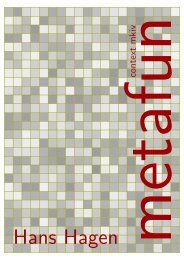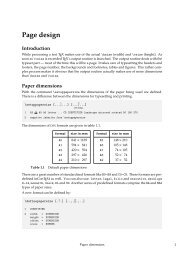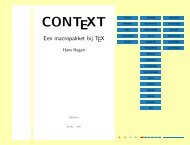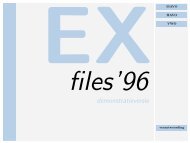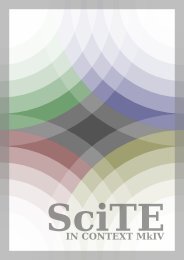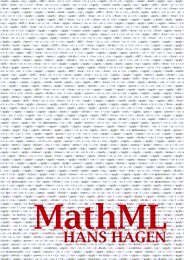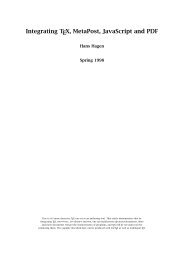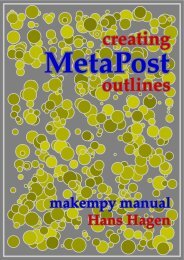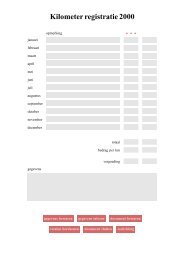Hagen - Pragma ADE
Hagen - Pragma ADE
Hagen - Pragma ADE
You also want an ePaper? Increase the reach of your titles
YUMPU automatically turns print PDFs into web optimized ePapers that Google loves.
8 Extensions<br />
8.1 Introduction<br />
One of the benefits of using T E X is that you can add your own features and try to optimize<br />
the look and feel. Of course this can also go wrong and output can look pretty awful when<br />
you don’t know what you’re doing, but on the average it works out well. In many aspects<br />
the move to an Unicode data path and OpenType fonts is a good one and solves a lot<br />
of problems with traditional T E X engines and helps us to avoid complex and ugly hacks.<br />
But, if you look into the source code of ConT E Xt you will notice that there’s still quite<br />
some complex coding needed. This is because we want to control mechanisms, even if<br />
it’s only for dealing with some border cases. It’s also the reason why LuaT E X is what it<br />
is: an extensible engine, building on tradition.<br />
As always with T E X, fonts are an area where many tuning happens and this is also true<br />
in ConT E Xt. In this chapter some of the extensions will be discussed. Some extensions<br />
run on top of the (rather generic) feature mechanism and some are using dedicated<br />
code.<br />
8.2 Italics<br />
Although OpenType fonts are more rich in features than traditional T E X and Type1 fonts,<br />
one important feature is missing: italic correction. This might sound strange but you<br />
need to keep in mind that in practice it’s a feature that needs to be applied manually.<br />
test {\it test\/} test<br />
It is possible to automate this mechanism and this is what the \em command does in<br />
MkII:<br />
test {\em test} test<br />
This command knows that it switches to italic (or slanted) and when used nested it knows<br />
to switch back. It also knows if a bold italic or slanted font is used. Therefore it can add<br />
italic correction between an italic and upright shape.<br />
An italic correction is bound to a glyph and bound to a font. In figure 8.1 we see how<br />
an italic shape extends out of the bounding box. This is not the case in Dejavu: watch<br />
figure 8.2.<br />
test test<br />
Latin Modern<br />
Roman Regular<br />
Latin Modern<br />
Roman Italic<br />
Figure 8.1 Italic overshoot in Latin Modern.<br />
127<br />
Extensions



